- Blind Marketing— Navigating Without Data and Direction
- The Blind Spot In B2B Digital Marketing
- Salesforce's Misstep with the Initial ‘Salesforce1’ Using Blind Marketing
- B2B Data Driven Marketing— An Effective and Efficient Approach
- How a Data-Driven Marketing Strategy is Executed?
- The Optimal Benefits of B2B Branding Strategy
- Attributes of Data-Driven Marketing
- Integrate B2B Data Driven Strategies To Contrive Intelligent Marketing with Market Pro
Imagine pouring your heart and soul into building a business and crafting a masterpiece with years of hard-earned expertise. You have perfected your product or service, ensuring every detail is flawless. After all that dedication, you have even taken on the challenge of marketing it and are confident in its potential to succeed.
Now, think of this business as not performing well after its launch. Why is that so? The answer to this is quite simpler than one would expect, “Blind marketing”.
Blind Marketing is basically the marketing efforts that feel like a shot in the dark and do not reach the target audience. Many B2B companies are stuck in the trap of blind marketing. They rely on their intuition and outdated methods that often miss the mark rather than reaching the targeted audience by doing proper market analysis.
Blind marketing not only wastes valuable resources but also fails to deliver visible results. To combat this, businesses can employ a game-changer strategy by embracing data driven B2B marketing. They can transform their marketing efforts from conjectures to precision by optimizing accurate data and advanced analytics of the current market.
This article will discover what blind marketing is and why it’s problematic. Moreover, it will provide in-depth information on data driven marketing and how to escape the blind marketing cycle. Along with this, how it harnesses the power of data to drive targeted and effective strategies that deliver real, impactful results.
Blind Marketing— Navigating Without Data and Direction
Recent studies show that blind spot monitor market is projected to increase from $10.6 billion in 2019 to $28.6 billion by the end of 2027 at the Compound Annual Growth Rate (CAGR) of 13.2% during the forecast period. This suggests that many businesses are not optimizing their marketing efforts based on data-driven insights. The phenomena is the literal meaning of what it is. Blind marketing indicates the selling of products or services without market information that includes data insights and proper analysis. It also refers directly to the conventional strategies that rely on the intuition of decision-makers and, more importantly, the outdated approaches used by the authorities.
Businesses fall behind in the market and struggle to connect with their target audience. This results in the creation of ineffective marketing campaigns, which leads to severe issues like resource wastage. It ultimately leads to poor return on investment (ROI) and missed opportunities for growth.
Moreover, the lack of flexibility and adaptability in old-school methods makes blind marketing quite difficult to improve outcomes and achieve the target. Using outdated marketing methods can restrict growth and lead to lower returns. It involves cold outreach and the creation of generic content, whereas data-driven marketing provides nurturing and tailored content that hits the spot.

The Blind Spot In B2B Digital Marketing
In order to understand the hurdles to success in a competitive market, it is important to identify the blind spot. In B2B digital commerce, the blind spot is overlooked, which leads to ineffective marketing strategies.
However, if addressed well, businesses can significantly enhance their marketing. They could also focus on their engagement with other companies or individuals and growth in the industry. These blind spots cause businesses to lose massive finances as their potential profits. It sabotages the B2B digital marketing of the business by not analyzing the trends and then making informed decisions that intercept its growth.

Salesforce’s Misstep with the Initial ‘Salesforce1’ Using Blind Marketing
Salesforce, a famous CRM software company whose product failed in 2014, has given a notorious but suitable example of blind marketing to the digital B2B community. Let’s see how.
Salesforce launched “Salesforce1,” which is a mobile application and is designed to revolutionize its CRM software experience on smaller devices. The company’s decision to launch the app was solely based on its optimistic projections. These were derived from internal evaluations, which were done by only the employees and not by the direct feedback of the user. Salesforce’s misstep had led them to a series of uncountable challenges.
As in the beginning and post-release, the app failed to provide the user the same experience they were enjoying on the website, and all due to a misalignment with the customer’s needs. It did not address the pain points of the user effectively, which resulted in an apathetic response. Furthermore, it also has several technical issues like bugs and system glitches which impede the user experience.
Despite Salesforce’s promise, for ease of use in its content marketing campaign, the insufficient training provided to it contributed to low adoption rates by the user. As a consequence of this, Salesforce faced significant backlash as users expressed their disappointment with the new mobile application.
This highlighted the additional investments Salesforce could have made in addressing the issues. It could work on enhancing training programs and re-evaluating marketing messages to avoid blind spots. This case serves as a reminder of the risks associated with relying solely on internal assumptions without incorporating user feedback, which is surely blind marketing. They could also employ beta testing and data-driven marketing strategies to avoid the backlash.
B2B Data Driven Marketing— An Effective and Efficient Approach
While addressing the limitations and the shortcomings of blind marketing, which plainly does not utilize any effective approach to marketize the product or the services. Understanding and utilizing data-driven B2B marketing in accordance with the business model is crucial. Blind marketing produces imprecise results due to inefficiencies and misallocation of resources.
Thus, marketers now emphasize employing for modern and effective techniques, such as data-driven marketing solutions. This enhances the reach and targets the relevant audience by performing various marketing analyses that provide the most suitable plan according to one’s business or service.
As the term suggests, it analyzes detailed customer data, market trends, and performance metrics to make strategic decisions. The substantial critical components of a data-driven marketing approach are:
- Data collection
- Data Analysis
- Data Integration

How a Data-Driven Marketing Strategy is Executed?
The data-driven B2B marketing has devised modern techniques to generate valuable gains. This is exclusively based on the growth marketing metrics and KPIs, along with the predictive analysis using sales forecasting techniques. Thus, to implement the data-driven content marketing strategy organize the given information and monitor the changes in it.

Data Collection
To analyze buyers’ or other companies’ behavior, B2B marketers collect data from a variety of sources so that they can understand the mindset and behavior of potential clients. They achieve this primarily through CRM systems, website analytics, and social media insights.
Popular CRM systems are Mailchimp, Salesforce, HubSpot, Pipedrive, Zendesk, Microsoft Dynamics 365, etc. The most commonly used social media management tools are Meta Business Suite, Hootsuite, Buffer, Sprout Social, etc.
Data Analysis
Data analysis is solely focused on interpreting the collected data from the sources. It helps in displaying different patterns and trends from the insights. For instance, identifying the most responsive audience or refining messages for the leads or the customers.
According to research, analysis of marketing data influences 53% of business decisions. These analytics can aid in shaping efficient organic marketing strategies by using analytical tools. The popular tools used for website analytics are SemRush and Google Analytics.
Strategy Development
The next step involves strategy development, with data insights playing a crucial role in identifying key trends. It also distills marketing endeavors and sets data-driven objectives for the businesses.
Moreover, it also helps create targeted campaigns that align with specific goals and for the relevant audience, which is, for sure, the decision-makers. It ensures more effective decision-making that improves audience engagement and optimizes overall performance in a competitive market.
Data Integration
The final and most important step is data integration, which incorporates information from different platforms into a unified system. This gives marketers a comprehensive view of customer journeys and makes campaign tracking KPIs and metrics. This involves merging, transforming, and standardizing data from multiple systems, databases, or formats to be accessed and used together.
Along with this, it helps with decision-making more efficiently as it improves the accuracy of insights. Data integration streamlines business processes and supports seamless data flow. It defines which data has been used and which system can still be used in the marketing campaigns.
Monitoring and Optimization
Additionally, there is monitoring of the ongoing processes that involve tracking performance and making data-driven adjustments to ensure marketing strategies remain effective. It allows marketers to identify enduring trends and track critical metrics quickly by optimizing the automation of the processes.
It makes intelligent and informed decisions for improved outcomes in an efficient strategy refinement. Moreover, using data visualization tools enhances this process by simplifying complex data, such as Excel, Tableau, and Google Data Studio.
The Optimal Benefits of B2B Branding Strategy
A strong B2B branding strategy that is conducted by data-driven insights has numerous benefits. It helps focus on specific markets by improving strategic marketing objectives and elevating business growth.

Enhanced Targeting
Data helps to understand better and target specific groups by identifying key demographics, behaviors, and preferences. This ensures that marketing endeavors reach the targeted audience more accurately.
Improved ROI
Data-driven strategies improve marketing budgets as by focusing on top-performing channels and tactics for optimization. This helps companies prioritize their revenue marketing strategy and achieve higher ROI.
Personalization
Using the available data for B2B marketing helps create personalized experiences that are tailored to targeted companies’ or peoples’ preferences, needs, and behaviors. This strengthens optimal engagement and enhances overall client satisfaction.
Agility
Real-time data allows businesses to quickly adjust and improve their strategies. This makes sure they can stay flexible and responsive to the changes in the market and what customers really want.
Enhanced Lead Generation
Analyzing engagement history, demographics, and behavioral patterns allows marketers to discover high-potential leads. This also helps in developing strategies that lead to successful lead generation for more significant attraction.
Increased Sales and Conversions
Data-driven methods help optimize sales funnels and marketing measures to dissuade blind marketing tactics. This leads to better conversion rates and increased revenue from more targeted yet effective campaigns.
Automated Marketing Processes
Data in marketing automation makes campaigns more efficient and consistent. It organizes the whole workflow and makes it easy to add automations. It leads to improved productivity and allows businesses to focus on strategic goals.
More Informed Decision-Making
Businesses can make better decisions and reduce risks by using comprehensive data insights. Data-driven optimization of operations improves the accuracy of their strategic choices in B2B branding.
Competitive Advantage
It helps businesses stay ahead of their competitors by allowing them to continuously refine their methods and find new opportunities by providing more relevant marketing experiences.
Attributes of Data-Driven Marketing
- Data Modeling: Draw a proper conclusion to identify customer behavior trends to develop better strategies, as 76% of marketers make decisions based on data analytics.
- Predictive Analytics: Use the available data to predict how customers will behave in the future.
- Customer Segmentation: Create segments of the audience, considering different aspects of data.
- Sales Forecasting: Estimate sales based on past sales trends and market data as the global Big Data Analytics Market is expected to be worth over $650 billion by 2029.
- Data-Driven Decision Making: Use data insights instead of intuition when making marketing decisions.
- Marketing Metrics & KPIs: Monitor the KPIs that are responsible for optimizing ROI, including CAC and LTV, as leading marketers are 72% more likely than the mainstream to invest in improving their first-party data.
- Data Visualization: Use tools to deliver an appropriate visual understanding of data.
Integrate B2B Data Driven Strategies To Contrive Intelligent Marketing with Market Pro
Data-driven B2B marketing strategies have helped organizations make better decisions and further enabled them to create excellent campaigns to improve overall performance. With data-driven insights, businesses can optimize how to connect with their customers better by increasing personalization in marketing efforts to really improve the bottom-line results from the competitive markets.
Looking to amplify your B2B marketing efforts? Partner with MarketPro to develop intelligent strategies and enhance customer experience. Our marketers ensure genuine growth using data-driven insights.

